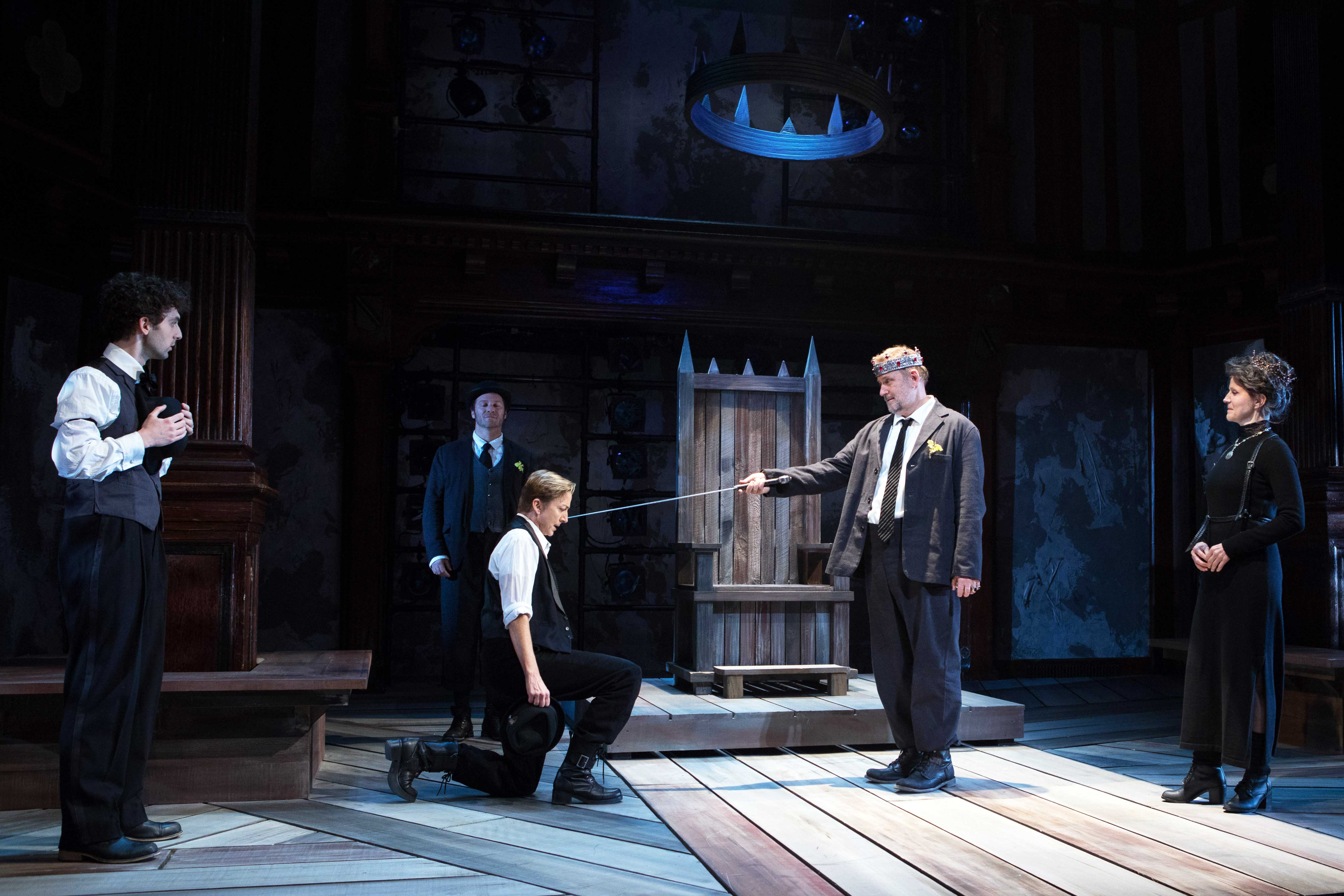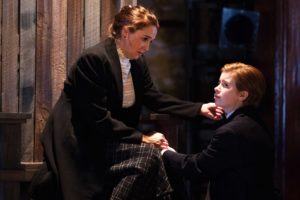King John is so rarely performed (indeed, it’s been a decade since I last saw it staged) that the current Aaron Posner-directed production at the Folger Theatre opens with a primer on the players and plot to help the audience navigate through the unfamiliarity.

In short: soon after John (Brian Dykstra) ascended to the English throne in 1199, the French King Philip (Howard D. Overshown), in an alliance with the King of Austria (Maboud Ebrahimzedah) decided to back the claim of Constance (Holly Twyford), that her son, John’s 12-year-old nephew Arthur (Megan Graves), the Duke of Brittany, is the rightful wearer of the crown. History records that John would rule until his death in 1216, even if the events seem to flow at a breakneck speed.
The play is so unfamiliar it is oft erroneously described as an early draft of Richard III – but there is little that the two have in common beyond monarchs whom popular memory records as villains – indeed the Bard’s portrait is far more nuanced than John’s frequent appearances as Robin Hood’s “Bad King John.” Whereas Richard’s policies are driven by what we moderns might interpret psychopathy renaissance prejudices that physical disability was a sign of a misshapen soul, John’s villainy is a product of realpolitik, lapses in judgment and the unintended consequences of both.
John had not murdered his way to the top. The crown was forced upon him as three elder brothers died before they could be crowned, and a fourth, Richard the Lionheart, at war. Though he never expected to sit on the throne, John seems surprisingly prepared. He thoughtfully considers advice whether from his mother, Queen Eleanor (Kate Goehring), or Philip Faulconbridge (Kate Eastwood Norris). When nephews are locked in a dispute over who shall inherit the lands of John’s elder brother Richard, he prefers to create a win-win situation, making Faulconbridge his loyal lieutenant.
When the dispute with the French King Philip leads to two armies standing outside the walls of Angers – a city that claims loyalty to the King of England, if only they could decide who the king might be – it is Angers in France who suggests a peaceful solution. But it is John who seizes the opportunity and sweetens the deal so that France might accept it – marrying his niece, Blanche of Spain (Alina Collins Maldonado) to the Dauphin (Akeem Davis) and even offering consolation prizes to his rival claimant Arthur and his mother, Constance. Indeed, we have a rare instance of Shakespearean kings brokering peace – even if it cannot last.
Dykstra brings both gravitas and a conscience to a king, who nonetheless attempts to rise to the role for which he was never expected, while also giving a comic subtext to his insecurity at having his legitimacy repeatedly questioned: He often points to his crown, as if to remind everyone it’s there; his shoes seem to not fit, with his toes catching on steps. Despite his stumbles, he goes toe-to-toe and army-to-army with his chief antagonists, Overshown’s France, Davis’ Dauphin, and Ebrahimzedah’s Austria.
Graves plays Arthur brilliantly as a boy young enough to constantly seek approval from the adults in his life, yet smart enough to read the room. He grasps that the affection he receives is at least partially informed by their dynastic interests and the danger of becoming an inconvenient fact. Graves’ scene with Elan Zafir’s Hubert, in whose care John has placed Arthur, elicits heart-wrenching performances from both actors.
In neglecting King John for so many decades, we have also neglected some of the Bard’s great dramatic roles for women (scarce in the history plays). Particularly noteworthy is Twyford’s intense portrayal of Constance, in which the roles of mother and political actor are entwined as she negotiates her son’s birthright – and all her hopes are dashed and her heart is broken. Yet even in her mourning, she carries the rage that allows her to stand against cardinals and kings. Goehring gives Eleanor the presence as a strategist that makes the Queen’s death palpable as a loss to her son and kingdom. Likewise, Maldonado’s Blanche, who is caught between her two warring families and nations, does not shrink from her role in the fight.

Norris’ Faulconbridge is most self-aware that he is playing a role: as a bastard, his status depends on his king’s patronage and is self-conscious about what it means to act as a noble. Even as Faulconbridge gives his king the most bloodthirsty council at Angers, Norris charms the audience.
Posner makes some unconventional yet powerfully memorable directorial choices. Most notably, rather than relying on a fight choreographer to craft the battle scenes, he uses lighting effects and excerpts from many of Shakespeare’s battle speeches to evoke war through poetry, without ever portraying it. Also gripping is the deft manner that Posner handles both the politicking that nearly causes, and the diplomacy that averts, a slaughter at Angers, and then again how the peace is broken in the next act when Papal Legate Cardinal Pandulph (Sasha Olinick) pries apart France and England’s tight embrace with a threat of excommunication (Shakespeare presents John and Faulconbridge as a Protestants avant-la-lettre.)
Lighting Designer Max Doolittle is the ace up Posner’s sleeve, using color, light, and shadow to represent conflict, violence, loss, and resignation in an abstract manner that always draws attention to the actors’ often visceral performances – in particular, Arthur’s death scene. Sarah Cubbage dresses the cast in late-Victorian/Edwardian fashions, with Blanche’s outfit of a black-and-white checked dress and bowler hat suggesting that she is ahead of her time while using flowers in lapels to represent the dynasties: the bluet de France and the Plantagenet’s common broom. Composer and Sound Designer Lindsay Jones has given the show an appropriately martial score of pipes and drums informed by, but not derivative of, early music.
Dramaturg Michelle Osherow has pared down the original script, giving it a strong sense of symmetry and a momentum that makes 135 minutes seem fast-paced. Unlike other history plays, King John seems to be as focused on statecraft – and the power and failures of diplomacy and negotiation – as it is on war, and at a time when diplomacy seems in tatters, it’s perhaps more relevant than ever.
Running time: Two hours and 15 minutes plus a 15-minute intermission.
King John plays through December 2 at The Folger Theater at 201 East Capitol Street SE, Washington, DC. For tickets call (202) 544-7077 or order online.





Shakespeare, so far from the truth… Arthur was murdered by King John or by one of his men and didnot have an accident while he was intented to escape from his jail… Arthur was the real heir of the english crown because his father, Geoffroy, was older than his brother John. That’s why John killed his nephew. And Constance died two years before his son and not after him.
Thanks for your response, Borgnis Desbordes Eric.
Shakespeare leaves it an open question over whether John’s claim or Arthur’s claim is the most legitimate — though on balance, whatever Shakespeare does to humanize John, his John is much more of a villain than either Arthur or Constance, both of whom are treated far more sympathetically in his text — even in this production.
As to seeking historical truth about the reigns of English monarchs: Shakespeare should never be your primary source. His plays serve a different purpose.
Thank you for your response Ian. Shakespeare is so far from the truth that he mustn’t be the primary source of anybody. But yes, his play deserves to be seen.